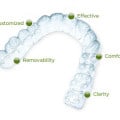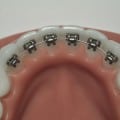What Are the Signs? (Braces May Be Needed)
Last Updated on March 5, 2019 by Guest Post
Braces. Few children grow up to have perfect teeth. Despite the best efforts of parents to train their kids in effective dental hygiene and twice-a-year checkups with a dentist, permanent teeth may display problems. Common dental concerns include teeth that do not come in when they should or in their designated place. Uneven alignment between upper and lower teeth is another issue. In fact, there are several scenarios that suggest someone may need or benefit from orthodontic treatment.

What is Orthodontic Treatment?
Orthodontia is the dental specialization that deals with teeth position and arrangement. It often involves moving teeth into correct or more effective positions. One or more teeth may create problems that interfere with biting, chewing, or even speaking. Addressing the problem at an optimum age helps to ensure the best possible outcome.
Typically, children should be evaluated for potential orthodontic work during their elementary school years. In fact, the age of seven is recommended by many orthodontic specialists. The specialist evaluates problems like an overbite or an underbite, crowding teeth, gaps and spaces, and jaw disorders. Failing to address these issues can eventually lead to tooth cavities, gum disease, earaches, headaches, and eating or speaking difficulties.
How are Teeth Straightened?
Teeth that are crooked, tilted, or tipped can often be corrected during orthodontic treatment. Depending on the examination findings, an orthodontist may suggest the placement of dental wires threaded through brackets that are bonded to the teeth to move teeth into their correct positions. The most suitable age for brackets and wires is when a child is a preteen (ten) or young teenager (fourteen). Since the affected parts are still growing, the teeth are easier to adjust with orthodontic treatment.
If teeth need to be moved, there are treatment options, with three types of braces. Metal brackets are traditional and are still widely used. Ceramic and plastic brackets may be clear or tinted to match the tooth color. They are not as noticeable as metal brackets and are well tolerated by most wearers. The lingual type adheres to the back side of teeth and can’t be seen by others. Wires connect the brackets and work to move the move into the desired positions.
A more recent style is a clear, removable appliance called aligners. A special version is called Invisalign. They can’t be seen, which boosts the confidence of young patients. For hygiene purposes, they can be removed to let the teeth be thoroughly brushed and flossed, which helps to deter decay. Aligners are switched after two weeks and are often used by patients with minimal spacing issues. Young patients who do not yet have permanent teeth do not wear aligners.
What if Teeth are Crowded?
The first phase of a treatment plan consists of wearing a palatal expander by those whose mouths are overly crowded by the teeth. In addition, if there are numerous permanent teeth that are crowding the mouth and making it difficult to straighten those that need work, some teeth may be extracted. Others may be shaved down on the external surface to help them fit more comfortably and neatly within the mouth.
The second phase takes place during adolescence and involves the placement of wires to move teeth to where they need to be. Most people undergo orthodontic treatment for between one and two years, although the amount of time may vary depending on the patient’s circumstances. When the wires are removed and the teeth are in their new, correct position, patients wear a retainer for a designated amount of time to maintain the teeth in their correct places until surrounding mouth tissues are aligned with the newly-even teeth.
Is Treatment Difficult?
Bonding the brackets to the teeth takes time and may be somewhat uncomfortable at first. In subsequent visits, the orthodontist will usually tighten the wires to continue moving the teeth to their target locations. After these visits, the teeth may feel slightly sore for a short time. But since they continue to move consistently due to the tightened wires, they will soon feel comfortable again.
Does Dental Hygiene Change During Treatment?
While wearing corrective wires on teeth, hygiene is more important than ever. In addition to brushing after every meal with a soft-bristle toothbrush, patients should be sure to floss, taking care to use a flossing threader to get between the brackets and below the wires. Dental checkups are recommended every six months, along with professional dental cleanings to ensure the teeth remain healthy. Failure to maintain adequate cleaning can lead to dark stains around brackets and bands on the teeth. Of course, if the patient experiences dental pain that feels like a cavity between six-month checkups, a dentist appointment should be made to get it checked.
What are Other Problems that May Require Braces?
Before placing metal, ceramic, or Invisalign brackets on teeth, the specialist will look at related issues like gum health, teeth root decay, and jaw joint condition. If any of these areas need treatment, that will be factored into the equation for developing an overall treatment plan.
Crooked teeth do not have to be a persistent embarrassment. Professional orthodontia experts can provide a comprehensive examination and diagnosis, along with treatment recommendations, to correct malocclusions and related dental issues. Every child should be evaluated for the possible need of orthodontic treatment, although an increasing number of adults are seeking this type of treatment as well. If you think you or a family member might need orthodontic treatment, please contact Beach Braces for more information.
Like what you read? Comment below or CLICK on an APP LOGO to follow us and share the conversation
Beach Braces Orthodontics
220 N. Aviation Blvd
Suite A
Manhattan Beach
CA 90266
Phone: (310) 379-0006
What Are the Signs? (Braces May Be Needed)

Dr Patti Panucci attended the University of Louisville School of Dentistry for four years, where she graduated with a DMD degree (May 2000) among the Top 10 in her class. Following that, she headed west to Los Angeles to complete her three-year residency at one of the top-ranked orthodontic programs in the country – the University of Southern California.
Along with her certificate in orthodontics, Dr. Panucci earned a master’s degree in craniofacial biology. During those three years, she fell in love with Southern California beach life and decided that this was where her future lay.














Leave a Reply
Want to join the discussion?Feel free to contribute!